Paper Menu >>
Journal Menu >>
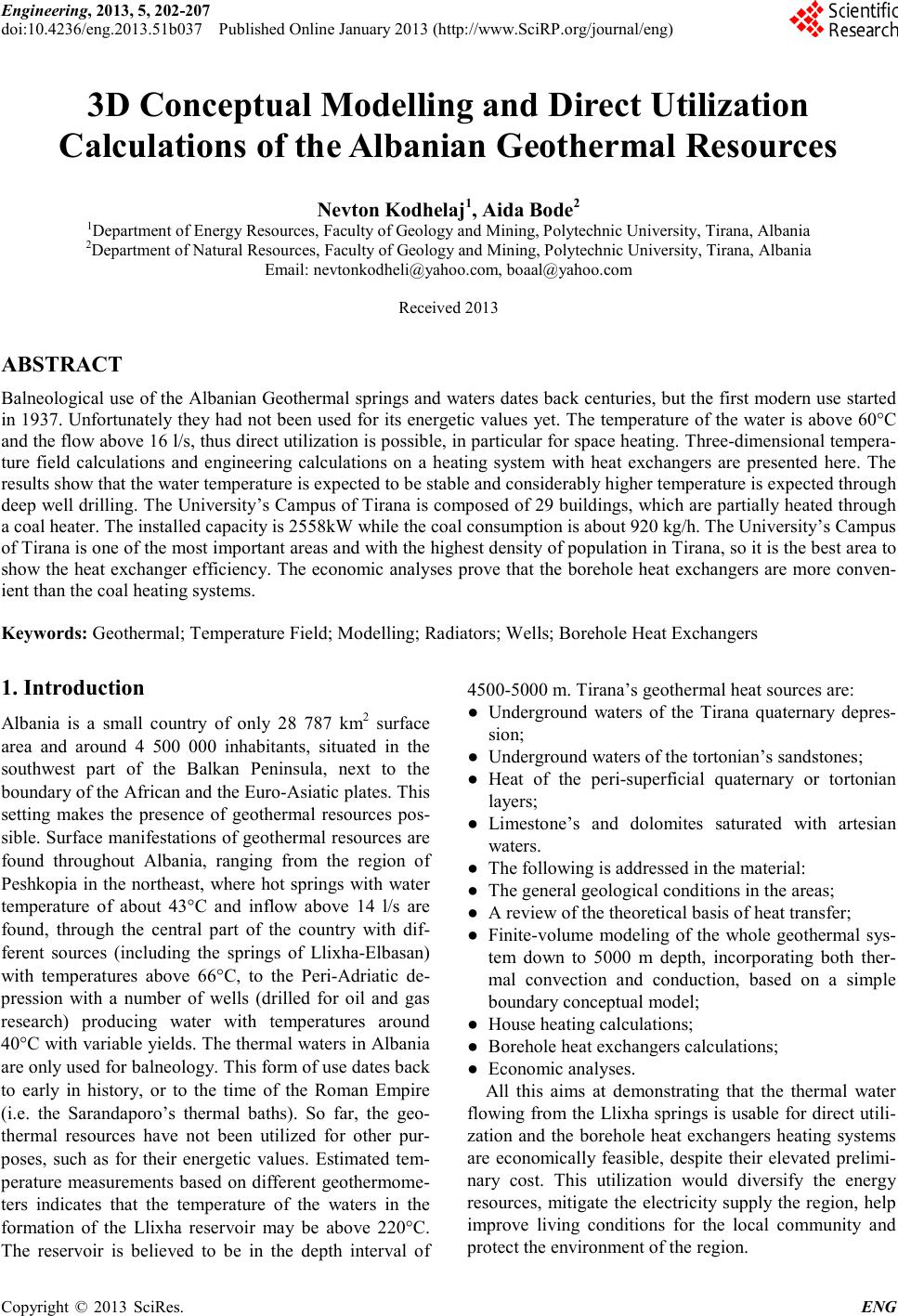 Engineering, 2013, 5, 202-207 doi:10.4236/eng.2013.51b037 Published Online January 2013 (http://www.SciRP.org/journal/eng) Copyright © 2013 SciRes. ENG 3D Conceptual Modelling and Direct Utilization Calculations of the Albanian Geothermal Resources Nevton Kodhelaj1, Aida Bode2 1Department of Energy Resources, Faculty of Geology and Mining, Polytechnic University, Tirana, Albania 2Department of Natural Resources, Faculty of Geology and Mining, Polytechnic University, Tirana, Albania Email: nevtonkodheli@yahoo.com, boaal@yahoo.com Received 2013 ABSTRACT Balneological use of the Albanian Geothermal springs and waters dates back centuries, but the first modern use started in 1937. Unfortunately they had not been used for its energetic values yet. The temperature of the water is above 60°C and the flow above 1 6 l/s, thus direc t utilization is po ssible, in particular for space heati ng. Thre e-dimensional te mpera- ture field calculations and engineering calculations on a heating system with heat exchangers are presented here. The results show that the water temperature is expected to be stable and considerably higher temperature is expected through deep well drilli ng. T he Unive rsit y’s Ca mpus o f Tir ana is c omposed of 29 buildings, which are partially heated through a coal heater. The installed capacity is 2558kW while the coal consumption is about 920 kg/h. The University’s Ca mpus of Tirana is one of the most important areas a nd with the hi ghest d ensit y of pop ulatio n in T ira na, so it is the bes t ar ea to show the heat exchanger efficiency. The economic analyses prove that the bor ehole heat exchangers are more conven- ient than the coal heating syst ems . Keywords: Geothermal; Temperature Field; Mode lling ; Radiato rs; Wells; Bo rehole Heat Exchangers 1. Introduction Albania is a small country of only 28 787 km2 surface area and around 4 500 000 inhabitants, situated in the southwest part of the Balkan Peninsula, next to the boundary of the A fri ca n a nd the Eur o -Asiatic p lates. T his setting makes the presence of geothermal resources pos- sible. Surface manifestations of geothermal resources are found throughout Albania, ranging from the region of Peshkopia in the northeast, where hot springs with water temperature of about 43°C and inflow above 14 l/s are found, through the central part of the country with dif- ferent sources (including the springs of Llixha-Elbasan) with temperatures above 66°C, to the Peri-Adriatic de- pression with a number of wells (drilled for oil and gas research) producing water with temperatures around 40°C with variable yield s. The thermal waters in Albania are only used for balneology. This form of use dates back to early in history, or to the time of the Roman Empire (i.e. the Sarandaporo’s thermal baths). So far, the geo- thermal resources have not been utilized for other pur- poses, such as for their energetic values. Estimated tem- perature measurements based on different geothermome- ters indicates that the temperature of the waters in the formation of the Llixha reservoir may be above 220°C. The reservoir is believed to be in the depth interval of 4500-5000 m. Tirana’s geothermal heat sources are: ● Underground waters of the Tirana quaternary depres- sion; ● Underground waters of the tortonian’s sand stones; ● Heat of the peri-superficial quaternary or tortonian laye rs ; ● Limestone’s and dolomites saturated with artesian waters. ● The following is addressed in the material: ● The general geological conditions in the areas; ● A re view of the theoretical basis of heat transfer; ● Finite-volume modeling of the whole geothermal sys- tem down to 5000 m depth, incorporating both ther- mal convection and conduction, based on a simple boundary conceptual model; ● House heating calculations; ● Borehole heat exchangers calculations; ● Economic analyses. All this aims at demonstrating that the thermal water flowing from the Llixha springs is usable for direct utili- zation and the borehole heat exchangers heating systems are economically feasible, despite their elevated prelimi- nary cost. This utilization would diversify the energy resources, mitigate the electricity supply the region, help improve living conditions for the local community and protect the environment of the region. 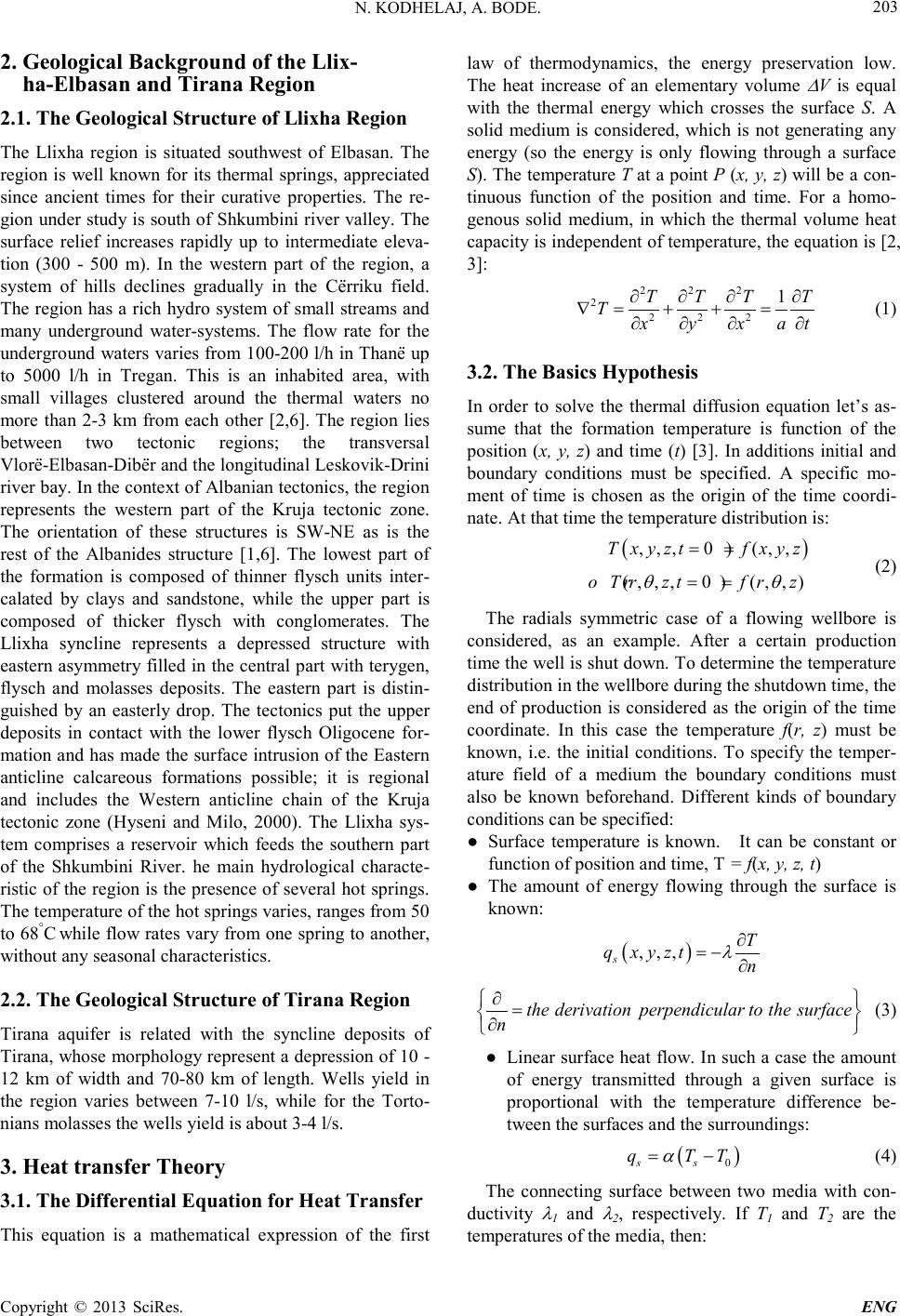 N. KODHELAJ, A. BODE. Copyright © 2013 SciRes. ENG 203 2. Geological Background of the Llix- ha-Elbasan and Tirana Region 2.1. The Geological Structure of Llixha Region The Llixha region is situated southwest of Elbasan. The region is well known for its thermal springs, appreciated since ancient times for their curative properties. The re- gion und er stud y is sout h of Shku mbini ri ver valle y. The surface relief increases rapidly up to intermediate eleva- tion (300 - 500 m). In the western part of the region, a system of hills declines gradually in the Cërriku field. The region has a rich hydro system of small streams and many underground water-systems. The flow rate for the under ground waters varies fro m 100 -20 0 l/h in Tha në up to 5000 l/h in Tregan. This is an inhabited area, with small villages clustered around the thermal waters no more than 2-3 km from each other [2,6]. The region lies between two tectonic regions; the transversal Vlorë-Elbasan-Dib ër and t he lo ngit ud inal Leskovi k-Drini river ba y. In the c onte xt o f Alb ania n tect onic s, t he re gio n represents the western part of the Kruja tectonic zone. The orientation of these structures is SW-NE as is the rest of the Albanides structure [1,6]. The lowest part of the formation is composed of thinner flysch units inter- calated by clays and sandstone, while the upper part is composed of thicker flysch with conglomerates. The Llixha syncline represents a depressed structure with eastern asymmetry filled in the central part with terygen, flysch and molasses deposits. The eastern part is distin- guished by an easterly drop. The tectonics put the upper deposits in contact with the lower flysch Oligocene for- mation and has made the surface intrusion of the Eastern anticline calcareous formations possible; it is regional and includes the Western anticline chain of the Kruja tectonic zone (Hyseni and Milo, 2000). The Llixha sys- tem comprises a reservoir which feeds the southern part of the Shkumbini River. he main hydrological characte- ristic of the region is the presence of several hot springs. The te mper at ur e of t he ho t sp r ing s var ies, r ange s from 50 to 68°C wh ile flo w rates var y from one spring to a nother, without any seasonal characteristics. 2.2. The Geological Structure of Tirana Region Tirana aquifer is related with the syncline deposits of Tirana, whose morphology represent a depression of 10 - 12 km of width and 70-80 km of length. Wells yield in the region varies between 7-10 l/s, while for the Torto- nians molasses the wells yield is about 3-4 l/s. 3. Heat transfer Theory 3.1. The Differential Equation for Heat Transfer This equation is a mathematical expression of the first law of thermodynamics, the energy preservation low. The heat increase of an elementary volume ∆ V is equal with the thermal energy which crosses the surface S. A solid medium is considered, which is not generating any energy (so the energy is only flowing through a surface S). The temperature T at a point P (x, y, z) will be a con- tinuous function of the position and time. For a homo- genous solid medium, in which the thermal volume heat capacity is independent of temperature, the equation is [2, 3]: 222 2 222 1TTT T Tat xyx ∂∂∂ ∂ ∇=+ +=∂ ∂∂∂ (1) 3.2. The Basics Hypo the si s In order to solve the thermal diffusion equation let’s as- sume that the formation temperature is function of the position (x, y, z) and time (t) [3]. In additions initial and boundary conditions must be specified. A specific mo- ment of time is chosen as the origin of the time coordi- nate. At that time the tempera ture distribution is: ( ) ,,,0)(,, (, ,,0)(, ,) Txyztf xyz orTrzt frz θθ = = = = (2) The radials symmetric case of a flowing wellbore is considered, as an example. After a certain production time the well is shut do wn. To determine the temperature distrib ution in the we llbore during t he shutd own time, the end of production is considered as the origin of the time coordinate. In this case the temperature f(r, z) must be known, i.e. the initial conditions. To specify the temper- ature field of a medium the boundary conditions must also be known beforehand. Different kinds of boundary conditions can be specified: ● Surface temperature is known. It can be constant or function of po sitio n and time, T = f(x, y, z, t) ● The amount of energy flowing through the surface is known: ( ) ,,, s T q xyztn λ ∂ = −∂ thederivationperpendiculartothesurface n ∂ = ∂ (3) ● Linear surface heat flow. In such a case the amount of energy transmitted through a given surface is proportional with the temperature difference be- twee n the surfaces and the surr oundi ngs: ( ) 0ss q TT α = − (4) The connecting surface between two media with con- ductivity λ 1 and λ 2, respectively. If T1 and T2 are the temperatures of the media, then:  N. KODHELAJ, A. BODE. Copyright © 2013 SciRes. ENG 204 12 121 2 ss ss TT TT nn λλ ∂∂ =−=− ∂∂ (5) 3.3. The Unstable Temperature Field Before starting investment in a geothermal project, the stability of the temperature field involved, in space and time, needs to be confirmed as well as the projects over- all sustainability. The methods that can be used to answer such questions are numerous, but here we will apply the finite element method (Osmani, 1997). Considering the differential equation: ( ) ,, 0 xyz TTT kkk x xyyz z T qxyzct ∂∂ ∂∂ ∂∂ ++ ∂∂∂∂∂ ∂ ∂ + −= ∂ (6) The funct ional of this equatio n is (Osmani, 1997) : 2 22 222 vr y xz XX X k kk TTT dxdydz xyz T q cdxdydz t Ω Ω = + ∂∂∂ =+ + ∂∂∂ ∂ +− ∂ ∫∫∫ ∫∫∫ (7) To integrate the Equation (7) let’s assume the time in- terval (t, t+Δt) through into dT/dt = C (Ti temperature values i n the nodes I = 1, 4). { } ( ) ( ) 1 2 1234 3 4 ;1, 4 1; 6 ,, vr ii i iii ii XX Xwhere i TT T T T T NNNNT T Nx y zabxcydz ∂∂ ∂ =+= ∂∂∂ = ∆ =+++ (8) = ∆ − − ∂ ∂∂ ∂∂ ∂∂ ∂ − − ∆ + ∆ + ∆ = ∂ ∂ ∂ ∂ ∂ ∂ ∂ ∂ = ∂ ∂ ∫∫∫∫∫∫∫∫∫∫∫∫ ∫∫∫∫∫∫∫∫∫∫∫∫ ∫∫∫∫∫∫∫∫∫∫∫∫ ∫∫∫∫∫∫∫∫∫∫∫∫ ΩΩΩΩ ΩΩΩΩ ΩΩΩΩ ΩΩΩΩ 0 0 0 0 1 1 1 1 4 Q t T t T t T t T dxdydzNdxdydzNNdxdydzNNdxdydzNN dxdydzNNdxdydzNdxdydzNNdxdydzNN dxdydzNNdxdydzNNdxdydzNdxdydzNN dxdydzNNdxdydzNNdxdydzNNdxdydzN T T T T ddddddd ddddddd ddddddd ddddddd 36 k ccccccc ccccccc ccccccc ccccccc 36 k bbbbbbb bbbbbbb bbbbbbb bbbbbbb 36 k T X T X T X T X T X 4 3 2 1 2 4 342414 43 2 3 2313 4232 2 2 12 413121 2 1 4 3 2 1 2 4 342414 4 3 2 3 2313 4332 2 2 12 413121 2 1 z 2 4 342414 43 2 3 2313 4332 2 2 12 413121 2 1 y 2 4 342414 43 2 3 2313 4332 2 2 12 413121 2 1 x 4 3 2 1 i (9) Using the numerical transformations the Equation (6) is transfor med as follows: ( ) 0 T HT PFt t ∂ +−= ∂ (10) H ddddddd ddddddd ddddddd ddddddd 36 k ccccccc ccccccc ccccccc ccccccc 36 k bbbbbbb bbbbbbb bbbbbbb bbbbbbb 36 k 2 4342414 43 2 32313 4332 2 212 413121 2 1 z 2 4342414 43 2 32313 4332 2 212 413121 2 1 y 2 4342414 43 2 32313 4332 2 212 413121 2 1 x = ∆ + ∆ + ∆ P dxdydzNdxdydzNNdxdydzNNdxdydzNN dxdydzNNdxdydzNdxdydzNNdxdydzNN dxdydzNNdxdydzNNdxdydzNdxdydzNN dxdydzNNdxdydzNNdxdydzNNdxdydzN 2 4 342414 43 2 3 2313 4232 2 2 12 413121 2 1 = ∫∫∫∫∫∫∫∫∫∫∫∫ ∫∫∫∫∫∫∫∫∫∫∫∫ ∫∫∫∫∫∫∫∫∫∫∫∫ ∫∫∫∫∫∫∫∫∫∫∫∫ ΩΩΩΩ ΩΩΩΩ ΩΩΩΩ ΩΩΩΩ F 4 Q= ∆ 4. District Heating System Using the Geothermal Water In general the geothermal water for districts heating sys- tems is taken directly from low temperature reservoirs. Anothe r way is t he use the geothe rmal wate r throug h the heat exchangers to heat up the fresh water. The hot water can be stored in tanks if appropriate. This water than is transmitted to the buildings and can be used for heating and tap water. Heat flo w to t he buildin gs is co ntrolled b y the mass flow. In the following are given the basics cal- culations for the geothermal district heating. The main elements of the geothermal district heating are the radia- tors and also this use is affected by the water thermal energy, building heat loss, pipe heat loss and building energy storage. 4.1. Boreho le Heat Ex cha n gers The equation for rate of heat transfer from the fluid in the heat exchange r to the earth mas s is [5 , 7]: 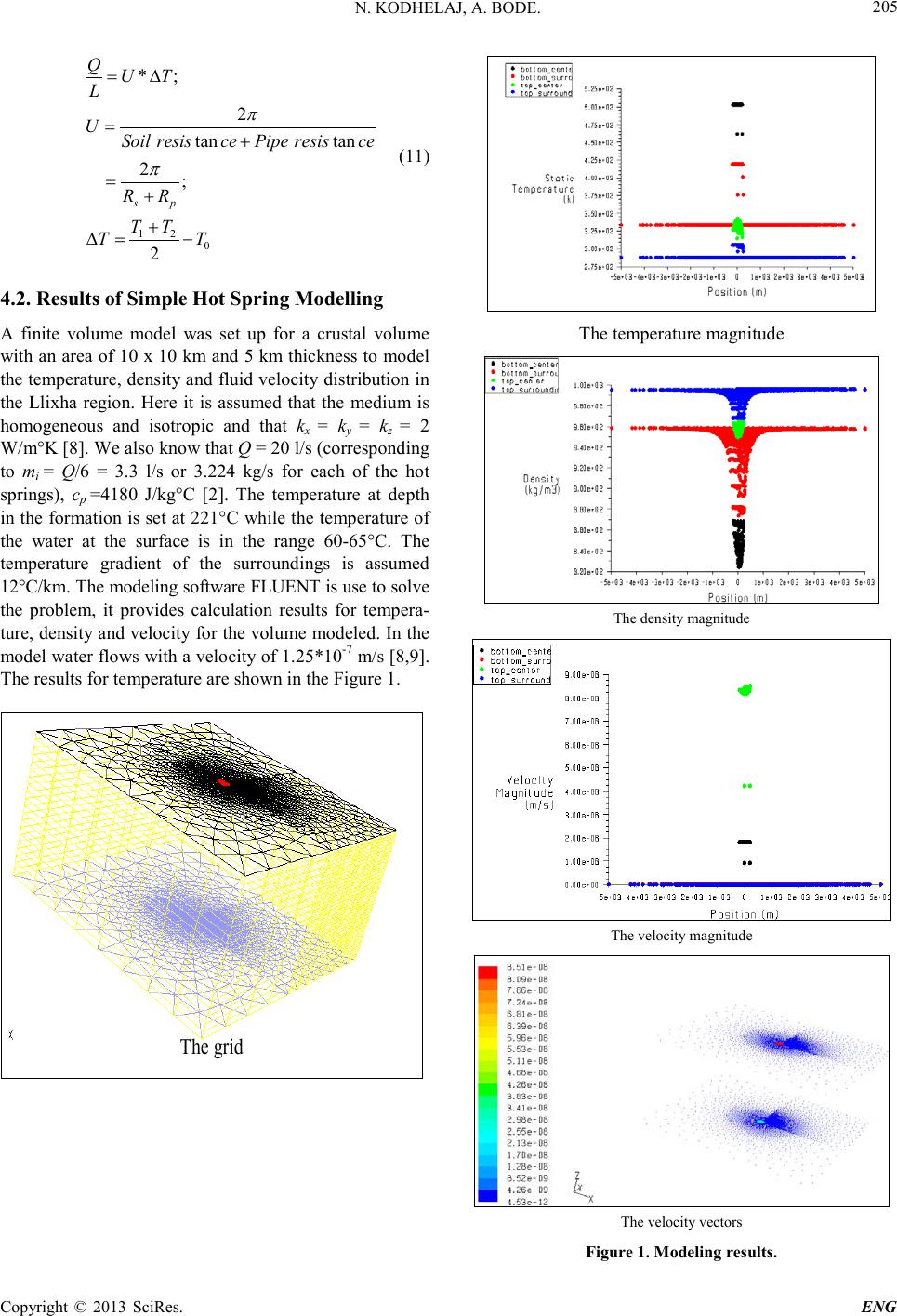 N. KODHELAJ, A. BODE. Copyright © 2013 SciRes. ENG 205 120 *; 2 tan tan 2 ; 2 sp QUT L USoilresis cePiperesis ce RR TT TT π π = ∆ =+ =+ + ∆= − (11) 4.2. Results of Simple Ho t Sprin g M od e ll in g A finite volume model was set up for a crustal volume with an area of 10 x 10 km and 5 km thickness to model the te mpe ratur e, de nsit y and fl uid velocity d istribution i n the Llixha region. Here it is assumed that the medium is homogeneous and isotropic and that kx = ky = kz = 2 W/m°K [8 ]. We al so know that Q = 20 l/s (corresponding to mi = Q/6 = 3.3 l/s or 3.224 kg/s for each of the hot springs), cp =4180 J/kg°C [2]. The temperature at depth in the formation is set at 221°C while the te mperature of the water at the surface is in the range 60-65°C. The temperature gradient of the surroundings is assumed 12°C/km. The modeling software FLUENT is use to solve the problem, it provides calculation results for tempera- ture, density and velocity for the volume modeled. In the model water flo ws with a velo city of 1.2 5*10-7 m/s [8,9]. The results for temperature are shown in the Figure 1. The gri d The temperature magnitud e The density magnitude The velocity magnitude The veloci ty vect ors Figure 1. Modeling results. 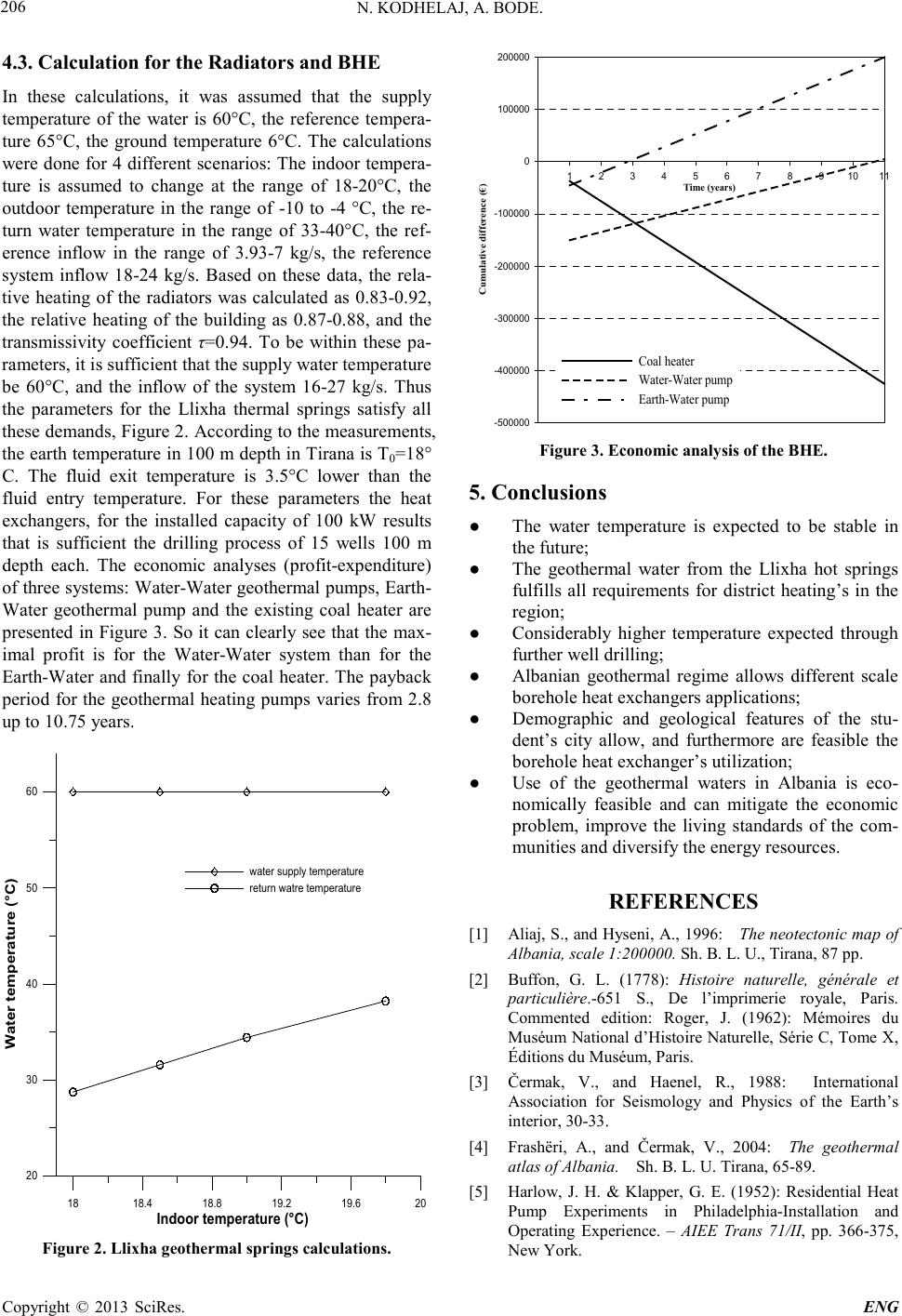 N. KODHELAJ, A. BODE. Copyright © 2013 SciRes. ENG 206 4.3. Calculation for the Radiators and BHE In these calculations, it was assumed that the supply temperature of the water is 60°C, the reference tempera- ture 65°C, the ground temperature 6°C. The calculations were done for 4 different scenarios: The indoor tempera- ture is assumed to change at the range of 18-20°C, the outdoor temperature in the range of -10 to -4 °C, the re- turn water temperature in the range of 33-40°C, the ref- erence inflow in the range of 3.93-7 kg/s, the reference system inflow 18-24 kg/s. Based on these data, the rela- tive heating of the radiators was calculated as 0.83-0.92, the relative heating of the building as 0.87-0.88, and the transmissivity coefficient τ=0.94. To be within these pa- rameters, it i s sufficient that the supply water temperature be 60°C, and the inflow of the system 16-27 kg/s. Thus the parameters for the Llixha thermal springs satisfy all these d e mand s, Fi gure 2. Acc or ding to the mea suremen t s, the earth temperature in 100 m depth in Tirana is T0=18° C. The fluid exit temperature is 3.5°C lower than the fluid entry temperature. For these parameters the heat exchangers, for the installed capacity of 100 kW results that is sufficient the drilling process of 15 wells 100 m depth each. The economic analyses (profit-expenditure) of three systems: Wa ter-Water geothermal pumps, Earth- Water geothermal pump and the existing coal heater are presented in Figure 3. So it can clearly see that the max- imal profit is for the Water-Water system than for the Earth-Water and finally for the coal heater. The payback period for the geothermal heating pumps varies from 2.8 up to 10.75 years. 18 18.4 18.8 19.2 19.620 Indoor temperature (°C) 20 30 40 50 60 Water temperature (°C) water supply temperature return watre temperature Figure 2. Llixha geothermal springs calculations. 1 2 3 4 5 6 7 8 910 11 Time (years) -500000 -400000 -300000 -200000 -100000 0 100000 200000 Cumulative difference (€) Coal heater Water-Water pump Earth-Water pump Figure 3 . Economic analysis of the BHE. 5. Conclusions ● The water temperature is expected to be stable in the future; ● The geothermal water from the Llixha hot springs fulfills all requirements for district heating’s in the region; ● Considerably higher temperature expected through further well drilling; ● Albanian geothermal regime allows different scale borehole heat exchangers applications; ● Demographic and geological features of the stu- dent’s city allow, and furthermore are feasible the borehole heat exchanger’s utilization; ● Use of the geothermal waters in Albania is eco- nomically feasible and can mitigate the economic problem, improve the living standards of the com- munities and diversify the energy reso urces. REFERENCES [1] Aliaj, S., and Hyseni, A., 1996: The neotectonic map of Albani a , sc al e 1:20000 0. Sh. B. L. U., Tira na , 87 pp. [2] Buffon, G. L. (1778): Histoire naturelle, générale et particulière.-651 S., De l’imprimerie royale, Paris. Commented edition: Roger, J. (1962): Mémoires du Muséu m Nation al d’Histoire Naturelle, S érie C, Tome X, Éditi ons du Mus é um, Pari s. [3] Čermak, V., and Haenel, R., 1988: International Association for Seismology and Physics of the Earth’s interior, 30-33. [4] Frashëri, A., and Čermak, V., 2004: The geothermal atlas of A lbania. Sh. B. L. U. Tirana, 65-89. [5] Harlow, J. H. & Klapper, G. E. (1952): Residential Heat Pump Experiments in Philadelphia-Installation and Operating Experience. – AIEE Trans 71/II, pp. 366-375, New York. 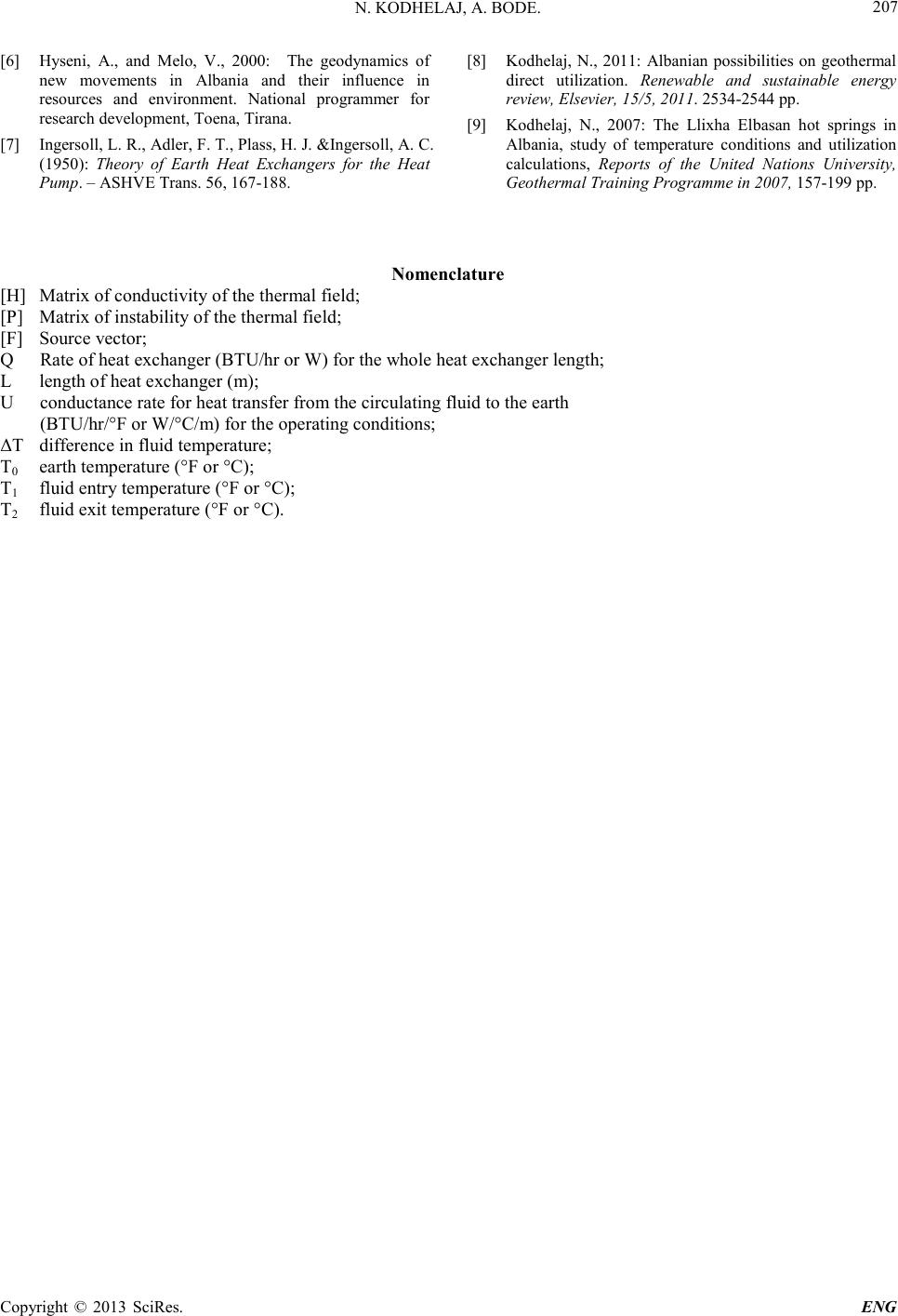 N. KODHELAJ, A. BODE. Copyright © 2013 SciRes. ENG 207 [6] Hyseni, A., and Melo, V., 2000: The geodynamics of new movements in Albania and their influence in resources and environment. National programmer for research develop ment, Toena, Tiran a. [7] Ingersoll, L. R., Adler, F. T., Plass, H. J. &Ingersoll, A. C. (1950): Theory of Earth Heat Exchangers for the Heat Pump. – ASHVE Trans. 56, 167-188. [8] Kodhelaj, N., 2011: Albanian possibilities on geothermal direct utilization. Renewable and sustainable energy review, Elsevier, 15/5, 2011. 2534-2544 pp. [9] Kodhelaj, N., 2007: The Llixha Elbasan hot springs in Albania, study of temperature conditions and utilization calculations, Reports of the United Nations University, Geothermal Training Programme in 2007, 157-199 pp. Nomencla ture [H] Matrix of conductivity of the thermal field; [P] Matrix of instabili ty of the the rmal field; [F] Source vector; Q Rate of heat exchanger (BTU/hr or W) for the whole heat exchanger length; L length of heat exchanger (m); U conductance rate for heat transfer from the circulating fluid to the earth (BTU/hr/°F or W/°C/m) for the operating conditions; ΔT differe nce in fluid temperature; T0 earth temperature (°F or °C); T1 fluid entry temperature (°F or °C); T2 fluid exit tempera ture (°F or °C) . |

